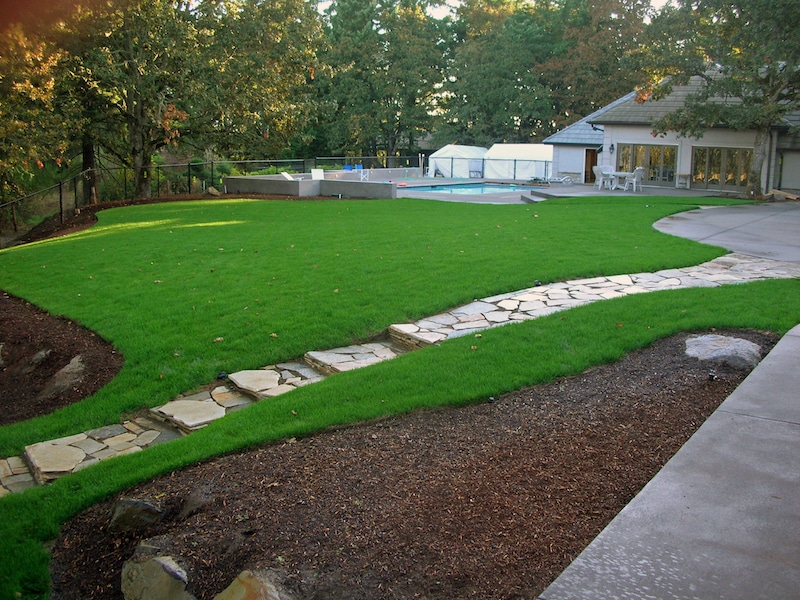Grass will grow healthy and green if your lawn soil provides the right amount of support and nutrition. Most people know the importance of fertilizer, but not the importance of loosening soil and roots. When that doesn’t happen, it can stifle the delicate roots and will eventually cause the grass to perish. Lawn aeration is the best way to loosen the soil and ensure it provides a comfortable anchor to your grass.
WHEN TO AERATE THE LAWN?
It’s important to follow a schedule when taking care of your lawn: from fertilizing to aerating. If you perform this procedure at the wrong time, you will damage the grass and that will lead to ugly brown patches in your lawn. Here’s how you determine when you should aerate the lawn:
- Cool-Season Grass – Cool-season grass thrives during the cooler temperatures of fall. This variety of grass takes advantage of the slow weed growth during this season. You should aerate lawns with this type of grass four weeks before the frost sets in. This allows the new grass to grow and thrive before the winter. You should aerate lawns with Creeping bentgrass, Kentucky bluegrass, Fescue, Rough bluegrass, and Ryegrass during fall.
HOW OFTEN SHOULD I AERATE THE LAWN?
If you aerate the lawn too often, you will damage the grass and the delicate balance of dormancy and growth. If you don’t aerate the lawn often enough, your grass will suffocate and the soil won’t support growth. A professional landscaper will take several aspects into consideration before they plan an aeration schedule for the lawn. As mentioned before, they consider the type of grass on your lawn. They also consider the type of soil because different kinds of soil react differently to weather conditions. There are two main types of soil in the Valley and textures can vary wildly so it’s vital to know what you’re working with before aeration.
- Clay Soil – Clay soil is sticky and wet. It can compact easily and become very hard when it dries down. This soil should be aerated once a year at the very least. You can aerate is more often if you notice the soil becoming hard and compacted a few months after the previous aeration.
- Sandy Soil – Sandy and granular soil isn’t sticky and doesn’t retain water as easily as clay soil does. This type of soil won’t compact easily so you can aerate it once a year or in alternating years. You still have to aerate it because eventually the pressure and gravity causes compaction in sandy soil as well.
METHODS TO AERATE THE SOIL
Landscape professionals can use one of two tools to aerate their lawns; the spike aerator and the plug aerator. The spike aerator, as the name suggests, has thin spikes that poke holes in the hardened soil in order to loosen it. The plug aerator removes small plugs of the soil to loosen it. The latter is much more effective and provides better aeration. Experienced landscapers use plug aerators more often than spike aerators, especially if the soil is severely compacted.
WHY SHOULD YOU AERATE THE LAWN?
Aeration is an essential step in lawn maintenance. Unfortunately, many property owners don’t realize this and try to cut corners by skipping it. Some assume that just adding water to the soil is enough to keep it loose and aerated. Here are some reasons why you shouldn’t skip aeration:
- Heavy Traffic and Regular Use – If you walk and play on the lawn, drive vehicles over it regularly, it will eventually become compacted because of the weight and pressure. Newly constructed homes and properties also have heavily compacted soil due to the movement of construction vehicles.
- Compacted Soil Will Ruin Your Landscaping Efforts – Compacted soil won’t allow new growth; if you don’t loosen the soil before the growing season, your lawn will eventually become dry and barren. You will have to start the whole seeding and fertilization process again and that would add to your expense. If regular aeration is a part of your annual lawn maintenance routine, you won’t have to worry about excessive compaction.
- Excessive Thatch – You need aeration if you have an excessive layer of thatch. Anything over 1½ inch must be removed so that the soil underneath can breathe and receive some sunlight.
- Improves Grass Health – When you aerate the lawn, you allow the sunlight, water, and nutrients to sink into the surface and reach the roots. This makes your turf stronger and ensures that your lawn looks lush and green. Aeration will also ensure the roots have more room to move and grow.
- Aeration Before Liming Can Help – Thorough aeration before liming can ensure the pH balance is restored at deeper levels rather than just on the surface. Aeration will also help new fertilizers sink in deeper into the soil.
As you can see, aeration is an important aspect of lawn care and will ensure it remains healthy. Proper and thorough aeration should be performed every year in order to maintain your lawn’s health. We recommend you call professionals to handle the task as they will have the right tools, skills, and knowledge.

